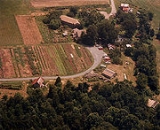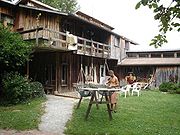
Twin Oaks
Encyclopedia

Ecovillage
Ecovillages are intentional communities with the goal of becoming more socially, economically and ecologically sustainable. Some aim for a population of 50–150 individuals. Larger ecovillages of up to 2,000 individuals exist as networks of smaller subcommunities to create an ecovillage model that...
and intentional community
Intentional community
An intentional community is a planned residential community designed to have a much higher degree of teamwork than other communities. The members of an intentional community typically hold a common social, political, religious, or spiritual vision and often follow an alternative lifestyle. They...
of about one hundred people living on 450 acres in Louisa County, Virginia
Louisa County, Virginia
Louisa County is a county located in the Commonwealth of Virginia. As of 2010, the population was 33,153. The county seat is Louisa.- History :...
. It is a member of the Federation of Egalitarian Communities
Federation of Egalitarian Communities
The Federation of Egalitarian Communities is a group of egalitarian communities which have joined together with the common purpose of creating a lifestyle based on equality, cooperation, and harmony with the Earth....
. Founded in 1967, it is one of the longest-enduring and largest secular intentional communities in North America. The community's basic values are cooperation
Cooperation
Cooperation or co-operation is the process of working or acting together. In its simplest form it involves things working in harmony, side by side, while in its more complicated forms, it can involve something as complex as the inner workings of a human being or even the social patterns of a...
, egalitarianism
Egalitarianism
Egalitarianism is a trend of thought that favors equality of some sort among moral agents, whether persons or animals. Emphasis is placed upon the fact that equality contains the idea of equity of quality...
, non-violence, sustainability
Sustainability
Sustainability is the capacity to endure. For humans, sustainability is the long-term maintenance of well being, which has environmental, economic, and social dimensions, and encompasses the concept of union, an interdependent relationship and mutual responsible position with all living and non...
and income sharing.
Founding
The community was founded on a 123 acre (0.49776378 km²) tobacco farm in 1967 by a group of eight individuals with no farming experience that included Kat KinkadeKat Kinkade
Kathleen "Kat" Kinkade was one of the eight co-founders of Twin Oaks, an intentional community in Virginia originally inspired by the behaviorist utopia depicted in B.F. Skinner's book Walden Two. Kinkade was the only one of the original founders to remain a community member for most of the...
, who has since written two books about the community. The community's initial inspiration was B.F. Skinner's novel Walden Two
Walden Two
Walden Two is a utopian novel written by behavioral psychologist B. F. Skinner, first published in 1948. In its time, it could have been considered to be science fiction, as the methods employed to alter people's behaviour did not yet exist....
, which describes a fictional behaviourist utopia
Utopia
Utopia is an ideal community or society possessing a perfect socio-politico-legal system. The word was imported from Greek by Sir Thomas More for his 1516 book Utopia, describing a fictional island in the Atlantic Ocean. The term has been used to describe both intentional communities that attempt...
. However, Skinner's vision quickly faded from prominence at Twin Oaks, as behaviorist principles were abandoned in favor of egalitarian principles. The community struggled greatly during its first few years, as member turnover was high and the community members didn't earn much income. According to Kinkade, the community avoided the problems stereotypically associated with communes (particularly laziness, freeloading, and excessive lack of structure) by adopting a structured, but flexible, labor system.
Modified versions of the community's initial organizational structure and labor credit system survive to this day. As in Skinner's novel, the original labor credit system utilized “variable” credit hours. Certain jobs were worth more credit hours than others in order to make each job desirable. The modified version of this plan in place today uses “standardized” credits; each job in the community is valued the same in terms of credit hours.
Life as a member

A member of Twin Oaks works around 42 hours a week. Some labor is directed toward generating income, and the rest consists of domestic work like gardening/food production, cooking, bike repair, building maintenance, cleaning, and child care. Most Twin Oakers perform a wide variety of tasks each week instead of spending all of their time in one labor area. Members can also choose to work outside of Twin Oaks. The income from this labor may go to the community, although some portion of it can go into a member's "vacation earnings." Excess labor done in a week accumulates as vacation time.
Though live television viewing is prohibited, Twin Oaks' members have access to the Internet as well as to public computers. Members can also watch movies and tapes of TV programs. People in the community often gather for other recreational activities such as dancing, meditating, discussing literature, staging musicals, and playing board games.
Twin Oaks members are religiously diverse. The membership includes Christians, Atheists, Pagans
Paganism
Paganism is a blanket term, typically used to refer to non-Abrahamic, indigenous polytheistic religious traditions....
, Buddhists, and more. The community hosts Pagan handfasting
Handfasting
Handfasting is a traditional European ceremony of betrothal or wedding. It usually involved the tying or binding of the right hands of the bride and groom with a cord or ribbon for the duration of the wedding ceremony.-Etymology:...
s, Equinox parties, and Thanksgiving dinners, and it celebrates June 16—the anniversary of its founding—as a holiday.
Residents live in dormitory-style living quarters spread out across the community. Each member has a private bedroom, but shares public spaces.
Member turnover is no longer as high as it was in the community's early years, and many Twin Oaks ex-members live in the nearby towns of Charlottesville
Charlottesville, Virginia
Charlottesville is an independent city geographically surrounded by but separate from Albemarle County in the Commonwealth of Virginia, United States, and named after Charlotte of Mecklenburg-Strelitz, the queen consort of King George III of the United Kingdom.The official population estimate for...
and Louisa
Louisa, Virginia
Louisa is a town in Louisa County, Virginia, United States. The population was 1,401 at the 2000 census. It is the county seat of Louisa County.-Geography:Louisa is located at ....
to maintain ties to the community.
Community businesses
Twin Oaks' 42 hour work week is divided between domestic and income-producing labor. Twin Oaks operates several community-owned businesses, including Twin Oaks Tofu, Twin Oaks Hammocks, and Twin Oaks Book Indexing. Additionally, members grow seeds for Southern Exposure Seed Exchange. From these sources, Twin Oaks generates $600,000 per year. This money pays for community upkeep and goods that cannot be produced on-site, and each member receives a monthly stipend for personal use (i.e. to purchase items that the community does not provide). In news segments, Twin Oakers often attribute the longevity of the community to its engagement in capitalism through its tofu and hammocks businesses.Twin Oaks and the communities movement
Twin Oaks has helped establish three sister communities: Acorn CommunityAcorn Community
Acorn Community is a medium-sized egalitarian, intentional community located in rural Virginia, USA and is a member of the Federation of Egalitarian Communities. Acorn was started in 1993 as a daughter community of the older, larger Twin Oaks. For reasons not entirely clear, the early 1990s saw a...
, about 7 miles (11.3 km) away from Twin Oaks, Living Energy Farm also in Louisa County Virginia and East Wind Community in south central Missouri.
Twin Oaks also hosts annual intentional community gatherings which are cosponsored by the Fellowship for Intentional Community
Fellowship for Intentional Community
The Fellowship for Intentional Community nurtures connections and cooperation among communitarians and their friends. It provides publications, referrals, support services, and sharing opportunities for a wide range of intentional communities, cohousing groups, ecovillages, community networks,...
. The Communities Conference and the Women's Gathering both take place in August every year.
Twin Oaks in the media
The history of Twin Oaks Community is detailed extensively in two books by Kathleen (Kat) Kinkade, one of the co-founders of the community. The first, A Walden Two Experiment, covers the first 5 years of the community. The second, Is it Utopia Yet?, covers the next 20 years. Another book from the 1980s, Living the Dream, by Ingrid Komar (the mother of a member at the time the book was written), also discusses Twin Oaks' history. Many newspaper and magazine articles have been written about Twin Oaks. About half a dozen dissertations and a dozen master's theses have been written about the community, as well. A list of such publications can be found on the community's website. In 1998, the Washington Post Magazine did a cover story on Twin Oaks.Twin Oaks and ecology
Twin Oaks seeks to be a model of sustainable living. The average Twin Oaks member consumes fewer resources than the average American citizen due to the community's practices in resource-sharing and self-sufficiency. Members hold all resources in common except for the personal items they keep in their bedrooms. For instance, members share housing, a fleet of 17 vehicles and a "large 'free clothing' library". Twin Oaks members consume 70% less gasoline, 80% less electricity and 76% less natural gas per individual compared to their neighbors.Criticisms of Twin Oaks
The community itself acknowledges that it has yet to create the perfect society—it even provides guidebooks entitled "Not Utopia Yet" to visitors. For instance, there is little privacy at Twin Oaks. Also, people who choose to live at Twin Oaks for several years—including founder Kinkade—sometimes feel "trapped" there. This is because members have little opportunity to build up equity or savings.Twin Oaks' founders were inspired by the utopian novel Walden Two by B.F. Skinner. In the early years of Twin Oaks, members engaged in behaviorist experiments to change personal behavior, but there was no attempt to impose behaviorism as a central guiding principle of the community. Behaviorist ideology persists at Twin Oaks today only in attempts to make conditions reinforcing in work areas (e.g treats and coffee being served, or live music being played). There is an absence of any form of punishment, which may be due to belief in behaviorism, but may also be due to an ideology of non-violence. Psychology classes touring Twin Oaks are disappointed at Twin Oaks' abandonment of behaviorist principles.
A common criticism of Twin Oaks both by visitors to Twin Oaks and by Twin Oaks members is that the community is dirty and cluttered. The egalitarian principle of the community and the self-choosing nature of the labor system means that there is no lower class to perform unpleasant work like cleaning. Visitors to Twin Oaks are often assigned work not of their choosing, but a community rule forbids visitors being scheduled cleaning work that a member doesn't also participate in.
Another criticism of Twin Oaks is that there is interpersonal conflict between members that the community does not attempt to resolve. Many other intentional communities prioritize interpersonal communication by making a condition of membership that extreme conflict must be worked out. Twin Oaks has a committee of facilitators called the "Process Team" that helps individuals resolve conflict, but participation is voluntary. Some members in conflict refuse to deal with their conflict through direct communication or through the Process Team. Twin Oaks has no formal consequences for these members.
The initial vision the founders had for Twin Oaks was to grow to a thousand members. A criticism supporters of Twin Oaks have is the community's unwillingness to grow. Twin Oaks has been at close to the same population size, around 100 people (including children), since 1996. During most of those years Twin Oaks has had a waiting list of people wishing to join.

